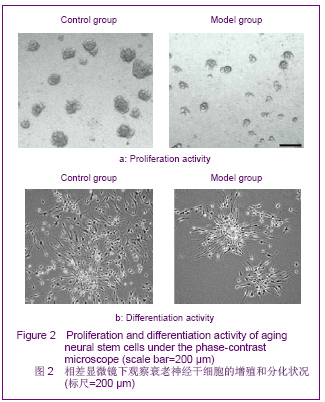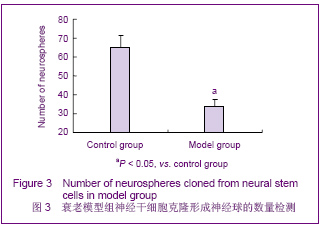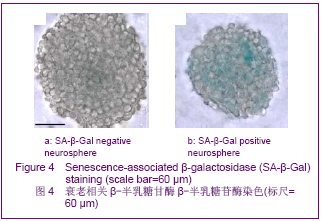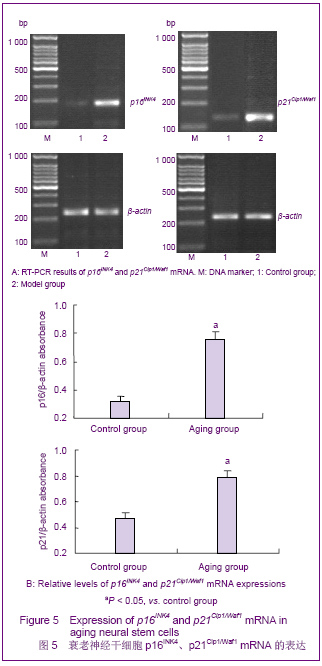| [1] Wang YP, Wu H, Wang JW, et al. Beijing Kexue Chubanshe. 2009:1-22.王亚平,吴宏,王建伟,等.干细胞衰老与疾病[M].北京:科学出版社, 2009:1-22.[2] Rossi DJ, Bryder D, Weissman IL. Hematopoietic stem cell aging: mechanism and consequence. Experimental Gerontology. 2007;42(5):385-390.[3] Gazit R,Weissman H,Rossi DJ.Hematopoietic stem cells and the aging hematopoietic system. Semin Hematol. 2008; 45(4): 218-224.[4] Gu YZ, Qiang YZ, Ni XT, et al. Zhongguo Zuzhigongcheng Yanjiu Yu Linchuang Kangfu. 2008, 12(34):6731-6734.古彦铮,强亦忠,倪祥庭,等.干细胞衰老学说[J].中国组织工程研究与临床康复,2008, 12(34):6731-6734.[5] Yu ZJ. Zhongguo Shiyong Yiyao. 2008;3(28):180-183. 余资江.脑衰老与神经干细胞移植治疗研究进展[J].中国实用医药, 2008, 3(28):180-183.[6] Duan JH, Zhu XL, Li XJ. Guoji BingliKexue Yu Linchuang Zazhi. 2011,31(4):291-295.段建辉,祝晓玲,李学军.神经干细胞衰老基础与临床研究进展[J]. 国际病理科学与临床杂志,2011,31(4):291-295.[7] Olariu A, Cleaver KM, Cameron HA. Decreased neurogenesis in aged rats results from loss of granule cell precursors without lengthening of the cell cycle. J. Comp. Neurol. 2007; 501(4): 659-667.[8] Rao MS,Hattiangady B,Shetty AK.The window and mechanisms of major age-related decline in the production of new neurons within the dentate gyrus of the hippocampus. Aging Cell.2006;5 (6):545-558.[9] Zhao CH, Chen XC, Jin JS, et al. Zhongguo Shenglibingli Zazhi. 2005;21(2):238-242.赵朝晖,陈晓春,金建生,等.三丁基过氧化氢诱导WI-38细胞衰老的细胞周期调控机制[J].中国生理病理杂志, 2005,21(2):238- 242.[10] Zhou Y, Yang B, Yao X, et al. Establishment of an aging model of Sca-1+ hematopoietic stem cell and studies on its relative biological mechanisms. In Vitro Cell Dev Biol Anim. 2011; 47(2):149-156.[11] Zhou Y, Yao B, Yao X, et al. Jiepou Xuebao. 2010;41(5):699- 705.周玥,杨斌,姚欣,等.小鼠造血干细胞体外衰老模型的构建及相关生物学研究[J].解剖学报,2010, 41(5):699-705.[12] Gu EY, Ha F, Li LF, et al. Zhongguo Zuzhigongcheng Yanjiu Yu Linchuang Kangfu. 2009,13(10):1948-1950.顾恩妍,哈福,李林凤,等.神经干细胞的鉴定方法[J].中国组织工程研究与临床康复,2009,13(10):1948-1950.[13] Tan XJ, Hu CL, Cai WQ. Guoji Naoxueguan Jibing Zazhi. 2006;14(2):107-109.谭新杰,胡长林,蔡文琴.新生大鼠海马神经干细胞的分离、培养、分化和鉴定[J].国际脑血管病杂志,2006,14(2):107-109.[14] Itoh T, Satou T, H ash im oto S, et a.l Isolation of neu ral stem cells from dam aged rat cerebral cortex after traum at ic b rain in ju ry. Neu roreport. 2005;16: 1687-1691.[15] Peng B, Wang CL, Feng L, et al. Zhongguo Xibao Shengwuxue Xuebao. 2011;33(10): 1116-1122.彭彬,王朝丽,冯丽,等.人参皂苷Rg1调控神经干细胞衰老作用及机制研究[J].中国细胞生物学学报,2011,33(10):1116-1122.[16] Zhao L, Zhang ZY, Tong TJ. Shengli Kexue Jinzhan. 2000; 31(3):205-210.赵亮,张宗玉,童坦君.生物体衰老与复制衰老——体内与体外研究[J].生理科学进展,2000, 31(3):205-210.[17] Rafalski VA, Brunet A. Energy metabolism in adult neural stem cell fate. Prog Neurobiol.2011;93( 2): 182- 203.[18] Pendergrass WR, Lane MA, Bodkin NL, et al. Cellular proliferation potential during aging and caloric restriction in rhesus monkeys (M acaca mulatta). J Cell Physio l.1999;180 (1):123-130.[19] Wang Y, Schulte BA, LaRue AC, et al. Total body irradiation selectively induces murine hematopoietic stem cell senescence. Blood. 2006;107(1):358-366.[20] Meng A, Wang Y, Brown SA, et al. Ionizing radiation and busulfan inhibit murine bone marrow cell hematopoietic function via apoptosis-dependent and independent mechanisms. Experimental Hematology.2003;31(12):1348- 1356.[21] Zheng WJ, Tong TJ, Zhang ZY. Shengmingdehuaxue. 2002; 22(4) :314- 316.郑文婕,童坦君,张宗玉.细胞衰老的重要通路:p16INK/ Rb和p19ARF/ p53/ p21Cip1信号途径[J].生命的化学, 2002,22(4): 314-316.[22] Shilkaitis A, Green A, Punj V, et al. Dehydroepiandrosterone inhibits the progression phase of mammary carcinogenesis by inducing celhlar senescence via a p16 - dependent but p53- independent. Breast Cancer Res.2005;7(6):R1132-1140.[23] Molofsky AV, Slutsky SG, Joseph NM, et al. Increasing p16INK4a expression decreases forebrain progenitors and neurogenesis during aging. Nature.2006; 443(7110):448-452.[24] Janakiraman K, Chad T, Matthew R, et al. Ink4a/Arf expression is a biomarker of aging. J Clin Invest.2004; 114(9): 1299-1307.[25] Guney I,Wu S,Sedivy JM.Reduced c-Myc signaling triggers telomereindependent senescence by regulating Bmi 1 and p16 (INK4a). Proc Natl Acad Sci USA.2006;103(10): 3645-3650.[26] Cammarano MS, Nekrasova T, Noel B, et al. Pak4 induces premature senescence via a pathway requiring p16 INK4/P19 ARF and mitogen activated protein kinase signaling. Mol Cell Biol.2005;25(21): 9532-9542.[27] Gong YH, Yue JP, Wu XD, et al. NSPc1 is a cell growth regulator that acts as a transcriptional repressor of p21Waf1/Cip1 via the RACE element. Nucleic Acids Res. 2006;34(21): 6158-1669. |




.jpg)
.jpg)
